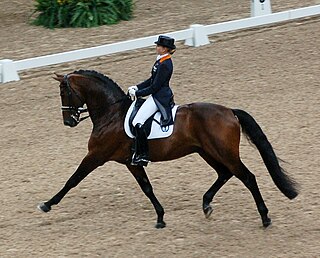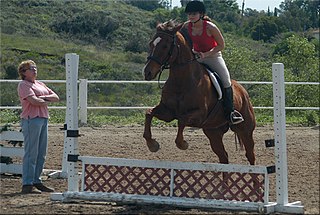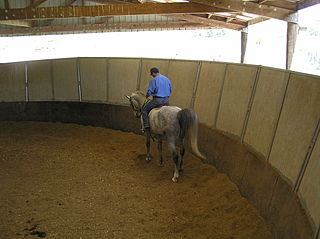Related Research Articles

Dressage is a form of horse riding performed in exhibition and competition, as well as an art sometimes pursued solely for the sake of mastery. As an equestrian sport defined by the International Equestrian Federation, dressage is described as "the highest expression of horse training" where "horse and rider are expected to perform from memory a series of predetermined movements.".

Equestrianism, commonly known as horse riding or horseback riding, includes the disciplines of riding, driving, and vaulting. This broad description includes the use of horses for practical working purposes, transportation, recreational activities, artistic or cultural exercises, and competitive sport.

The Lipizzan or Lipizzaner is a European breed of riding horse developed in the Habsburg Empire in the sixteenth century. It is of Baroque type, and is powerful, slow to mature and long-lived; the coat is usually gray.

Classical dressage evolved from cavalry movements and training for the battlefield, and has since developed into the competitive dressage seen today. Classical riding is the art of riding in harmony with, rather than against, the horse.

Reiner Klimke was a German equestrian, who won six gold and two bronze medals in dressage at the Summer Olympics — a record for equestrian events that has since been surpassed. He appeared in six Olympics from 1960 to 1988, excluding the 1980 Games that were boycotted by West Germany.

A double bridle, also called a full bridle or Weymouth bridle, is a bridle that has two bits and four reins. One bit is the bradoon, is a modified snaffle bit that is smaller in diameter and has smaller bit rings than a traditional snaffle, and it is adjusted so that it sits above and behind the other bit, a curb bit. Another term for this combination of curb and snaffle bit is a "bit and bradoon", where the word "bit" in this particular context refers to the curb.

Alois Podhajsky was the director of the Spanish Riding School in Vienna, Austria as well as an Olympic medal-winner in dressage, riding instructor, and writer. He competed at the 1936 Summer Olympics and the 1948 Summer Olympics.

A riding instructor is a person whose job it is to teach methods of horse riding to beginners and improve the intermediate and advanced rider's style and technique. A riding instructor may also serve as a coach for a rider in competition. Some instructors may work out of their own riding facility, others at a riding school or training center. With appropriate academic credentials, some may teach in a college or university equestrian studies program. Yet others freelance and travel from stable to stable.

Rollkur or hyperflexion of the horse's neck is defined as "flexion of the horse's neck achieved through aggressive force" and is banned in International and Olympic sanctioned equestrian sports by the governing body, the International Federation for Equestrian Sports (FEI). The FEI recognises a distinction between rollkur and the riding of the horse in a deep outline not achieved by force.
Nuno Oliveira was a Portuguese equestrian, horse trainer and dressage instructor. His teachings have inspired riders and trainers all over the world to adopt the 'baroque' or 'classical' style of working with the horse; an art which goes back hundreds of years and encompasses the fundamentals which most 'modern' disciplines can be traced back to.
Walter A. Zettl was a German dressage rider and Olympic-level dressage horse trainer. He was born in 1929 in Alt-Rohlau, Bohemia, which is now Stará Role in the Karlovy Vary region of the Czech Republic.

Vladimir Stanislavovitch Littauer was an influential horseback riding master and the author of books and films on educated riding and the training of horses. As a riding instructor, Littauer was in great demand during his lifetime by professionals and amateurs. He was considered an early, important and controversial advocate of the forward seat riding system during his career. He wrote more than a dozen books between 1930 and 1973 which sparked vivid debates among experienced riders of various backgrounds. He also wrote many articles on forward riding for the notable equestrian magazines of his day. His methods continue to be taught at Sweet Briar College and other riding programs.
Egon von Neindorff had a Riding Institution at Karlsruhe, Germany, where he trained horses and taught dressage. He was a teacher and his methods are the standard for the German School. One of his famous students is Erik Herbermann, author of the Dressage Formula. Von Neindorff was author of a book, The Art of Classical Horsemanship.

The round pen, sometimes called a bullpen, is a round enclosure used for horse training. They range in diameter from a minimum of 30 feet (9.1 m) to a maximum of 100 feet (30 m), with most designs 50 to 60 feet in diameter. Footing is usually sand or other soft dirt. The sides are 6 to 8 feet high, traditionally made of wooden posts with rails or wooden boards, although modern round pens are often made out of portable pipe panels that allow the pen to be made bigger or smaller, or to be moved.
Marji Armstrong is one of the pioneers of the classical philosophy of horsemanship in Australia. She has taught these classical principles to students around the world for the past two decades, both in person and via the internet, and now shares her thoughts and experience on Marji's Blog.

Richard Davison is an Olympic standard dressage rider.

The Escola Portuguesa de Arte Equestre is a Portuguese institution dedicated to the preservation of the equestrian arts, in the Portuguese tradition. It is one of the "Big Four", the most prestigious classical riding academies in the world.
Marius George Curteanu is a Romanian dressage rider and trainer. In 1984 he was selected for the Romanian National Equestrian Team. As a member of national team, he participated in international dressage competitions in Italy, Germany, Greece, Hungary, Poland, Turkey and Bulgaria, winning many prizes and medals. He has been riding over 35 years and his experience covers a wide range of equestrian work and a wide range of horses up to Grand Prix level in dressage.

Denny Emerson is an American equestrian. He is the only equestrian to have won both an international gold medal in eventing and a Tevis Cup buckle in endurance. In 1972, Emerson was named United States Eventing Association's Rider of the Year. He was a member of the United States Three Day Eventing Team that won the gold medal at the 1974 Eventing World Championships. As of 2015, Emerson operates as a clinician and trainer. He is a regular contributor to The Chronicle of the Horse's "Between Rounds" column. He and his wife, May Emerson, run Tamarack Hill Farms in Strafford, Vermont and Southern Pines, North Carolina.

Catherine Durand-Henriquet is a French equestrian. She was twice selected for the Equestrian at the Summer Olympics. She brought the first Iberian horse to International and Olympic levels and was also the first rider in the Versailles tradition to ever ride in the Olympic Games. She was national dressage champion multiple times. Together with her husband, famous equestrian and dressage master Michel Henriquet, she wrote a number of major dressage and horse training books and released a young horse training DVD series showing how the Henriquets take young horses from their first time under the saddle to the Grand Prix. Catherine Henriquet still actively shows Hanoverian horses and Lusitano horses at Grand Prix level and has trained dozens of horses to the Grand Prix. She currently rides two horses on the Big Tour: 18.7 hands Hanoverian gelding Lexus Gold and 15.7 hands Lusitano gelding Diabeau du Coussoul. Henriquet is also a retired dermatologist and always maintained professional practice while showing internationally. Having a full time profession aside from riding sometimes got in the way of being able to attend international shows and selections.
References
- ↑ Patton, Katie. "Paul Belasik Clinic November 23-24, 1996" Garland Farms Dressage Archived 2012-04-25 at the Wayback Machine
- 1 2 3 Paul Belasik: Pennsylvania Riding Academy at Lost Hollow Farm
- ↑ Hopf, Susan. "The Essential Paul Belasik: A Review"
- ↑ Welz, Yvonne. "What has Happened to Dressage? A Personal Perspective" April 2010